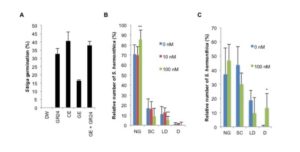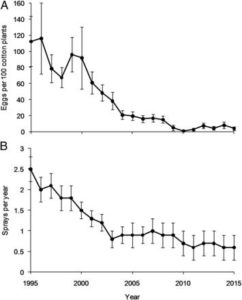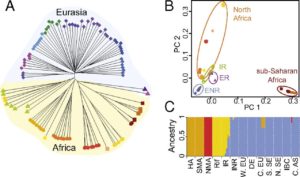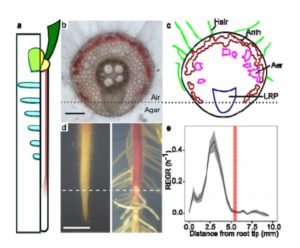Strigolactone-Gibberellin Cross Talk
 Strigolactones Root parasitic weeds, such as broomrape (Orobanche spp.) and witchers weed (Striga spp.), are harmful plants in sub-Saharan Africa, the Middle East, and Asia that maintain seed dormancy in the absence of host plant. Both parasitic plant species require germination stimulants released from the host plant. SLs are the major group of germination stimulants effective for almost all Orobanche and Striga spp. It has been reported that approximately 300 million people are affected economically by Striga spp. in Africa, with estimated losses of $US 7 billion SLs also regulate diverse physiological processes in plants in general, including shoot branching and root development. They also act as rhizosphere signaling molecules to stimulate the germination of root parasitic weeds and the branching of arbuscular mycorrhizal fungi. Although various types of cross talk between SLs and other hormones have been reported in physiological analyses, the cross talk between gibberellin (GA) and SLs is poorly understood. Ito et al. () screened for chemicals that regulate the level of SLs in rice (Oryza sativa) and have identified GA as a novel SL-regulating molecule. The regulation of SL biosynthesis by GA is dependent on the GA receptor GID1 and F-box protein GID2. GA treatment also reduced the infection of rice plants by Striga. GA is a regulator of SL biosynthesis, and that GA signaling controls the biosynthesis of SL by regulating the expression of SL biosynthesis genes. Moreover, GA-treated rice showed reduced Striga infection. These data not only demonstrate cross talk between SL and GA, but also suggest that GA might be used to control parasitic weed infections.
Strigolactones Root parasitic weeds, such as broomrape (Orobanche spp.) and witchers weed (Striga spp.), are harmful plants in sub-Saharan Africa, the Middle East, and Asia that maintain seed dormancy in the absence of host plant. Both parasitic plant species require germination stimulants released from the host plant. SLs are the major group of germination stimulants effective for almost all Orobanche and Striga spp. It has been reported that approximately 300 million people are affected economically by Striga spp. in Africa, with estimated losses of $US 7 billion SLs also regulate diverse physiological processes in plants in general, including shoot branching and root development. They also act as rhizosphere signaling molecules to stimulate the germination of root parasitic weeds and the branching of arbuscular mycorrhizal fungi. Although various types of cross talk between SLs and other hormones have been reported in physiological analyses, the cross talk between gibberellin (GA) and SLs is poorly understood. Ito et al. () screened for chemicals that regulate the level of SLs in rice (Oryza sativa) and have identified GA as a novel SL-regulating molecule. The regulation of SL biosynthesis by GA is dependent on the GA receptor GID1 and F-box protein GID2. GA treatment also reduced the infection of rice plants by Striga. GA is a regulator of SL biosynthesis, and that GA signaling controls the biosynthesis of SL by regulating the expression of SL biosynthesis genes. Moreover, GA-treated rice showed reduced Striga infection. These data not only demonstrate cross talk between SL and GA, but also suggest that GA might be used to control parasitic weed infections.


 Undergraduate research is a transformative experience for many early-career scientists, allowing them to experience the joys and pains of research first hand. Yu and Kuo offer some straightforward advice to help students gain the most from this opportunity. While some of the advice is directed towards computational biology students, most is broadly applicable (as in “Be organized”). This is a useful paper to pass on to young researchers! PLOS Comp Biol.
Undergraduate research is a transformative experience for many early-career scientists, allowing them to experience the joys and pains of research first hand. Yu and Kuo offer some straightforward advice to help students gain the most from this opportunity. While some of the advice is directed towards computational biology students, most is broadly applicable (as in “Be organized”). This is a useful paper to pass on to young researchers! PLOS Comp Biol.  Chloroplasts are of course the descendants of ancient endosymbiotic cyanobacteria. While there are examples of photosynthetic bacteria or algae living in animal tissues (e.g., anemones and corals), vertebrate endosymbiosis is rare. One exception is the interaction between a salamander Ambystoma maculatum and the green alga Oophila amblystomatis, which lives on and within the salamander’s eggs (oophila means egg-lover). The metabolic interactions between the two species have not been fully understood. Burns et al. took a transcriptomic approach, comparing the free-living, within-egg and on-egg algal transcriptomes, as well as those of the salamander host with and without the symbiont. Interestingly, one finding is that the algae within the cell are oxygen-deprived and may rely on fermentation for energy production, calling into question what benefit they get from this interaction. As the authors conclude, “Whether the intracellular algae are on the positive end of a net host benefit remains uncertain, however it is clear that the algae have an unconventional ‘photosymbiont’ role.” eLIFE
Chloroplasts are of course the descendants of ancient endosymbiotic cyanobacteria. While there are examples of photosynthetic bacteria or algae living in animal tissues (e.g., anemones and corals), vertebrate endosymbiosis is rare. One exception is the interaction between a salamander Ambystoma maculatum and the green alga Oophila amblystomatis, which lives on and within the salamander’s eggs (oophila means egg-lover). The metabolic interactions between the two species have not been fully understood. Burns et al. took a transcriptomic approach, comparing the free-living, within-egg and on-egg algal transcriptomes, as well as those of the salamander host with and without the symbiont. Interestingly, one finding is that the algae within the cell are oxygen-deprived and may rely on fermentation for energy production, calling into question what benefit they get from this interaction. As the authors conclude, “Whether the intracellular algae are on the positive end of a net host benefit remains uncertain, however it is clear that the algae have an unconventional ‘photosymbiont’ role.” eLIFE  Biotic interactions are complex; any effort by the prey/host to defend against the predator/pathogen provides selective pressure towards overcoming those defenses. As new herbivore control methods are developed they quickly lose effectiveness as the pests evolve resistance; this is true whether the control method is sprayed externally or produced internally as it is in transgenic crops expressing Bacillus thuringiensis (Bt) protein. Wan et al. report on an 11-year study in China in which the cotton planted was the F2 generation from a cross between Bt plants and non-Bt plants (in the F2 generation 75% of the plants express the dominant Bt trait). The authors found that resistance to Bt in pink bollworm was substantially delayed, as the non-Bt plants provide a refuge for susceptible individuals. Because the insects were successfully controlled, insect population and insecticidal spray use both declined during this period. The authors propose that the hybridization-based strategy might be an effective alternative where refuge planting is impractical. Proc. Natl. Acad. Sci. USA
Biotic interactions are complex; any effort by the prey/host to defend against the predator/pathogen provides selective pressure towards overcoming those defenses. As new herbivore control methods are developed they quickly lose effectiveness as the pests evolve resistance; this is true whether the control method is sprayed externally or produced internally as it is in transgenic crops expressing Bacillus thuringiensis (Bt) protein. Wan et al. report on an 11-year study in China in which the cotton planted was the F2 generation from a cross between Bt plants and non-Bt plants (in the F2 generation 75% of the plants express the dominant Bt trait). The authors found that resistance to Bt in pink bollworm was substantially delayed, as the non-Bt plants provide a refuge for susceptible individuals. Because the insects were successfully controlled, insect population and insecticidal spray use both declined during this period. The authors propose that the hybridization-based strategy might be an effective alternative where refuge planting is impractical. Proc. Natl. Acad. Sci. USA  Arabidopsis thaliana is a good study system to shed light on evolutionary processes. Its broad native range and genetic diversity provide resources to study speciation and local adaptation. Durvasula et al. studied the early history and transition to selfing of this species by comparing genome sequences of populations native to Eurasia and Africa. They found that speciation most likely occurred in Africa, where populations first transitioned to selfing. In addition, population dynamics are coincident with known climate shifts and demographic events of other species, including humans. (Summary by
Arabidopsis thaliana is a good study system to shed light on evolutionary processes. Its broad native range and genetic diversity provide resources to study speciation and local adaptation. Durvasula et al. studied the early history and transition to selfing of this species by comparing genome sequences of populations native to Eurasia and Africa. They found that speciation most likely occurred in Africa, where populations first transitioned to selfing. In addition, population dynamics are coincident with known climate shifts and demographic events of other species, including humans. (Summary by  Light controls many aspects of the lifecycle of photosynthetic organisms, including the green alga Chlamydomonas. Cryptochromes are a family of photoreceptors, of which there are four members in Chlamydomonas. One of these is known as the animal-type cryptochrome, aCRY. To investigate the function of aCRY, Zou et al. generated insertional mutants in aCRY that knocked down the protein level to less than 20% of wildtype. The mutant reveals that aCRY has both positive and negative roles in the mating cycle of the alga. Plant Physiol.
Light controls many aspects of the lifecycle of photosynthetic organisms, including the green alga Chlamydomonas. Cryptochromes are a family of photoreceptors, of which there are four members in Chlamydomonas. One of these is known as the animal-type cryptochrome, aCRY. To investigate the function of aCRY, Zou et al. generated insertional mutants in aCRY that knocked down the protein level to less than 20% of wildtype. The mutant reveals that aCRY has both positive and negative roles in the mating cycle of the alga. Plant Physiol.  Hydrotropism is the curvature of a plant root towards water. Previous work showed that the hormone abscisic acid (ABA), but not the auxin transporters AUX1 and PIN, is required for hydrotropism, demonstrating that the mechanisms of hydrotropism and gravitropism are distinct. Previous work also showed that MIZU-KUSSEI1 (MIZ1), a gene of unknown function, is required for hytrotropism. In this new work, Dietrich et al. showed that an ABA-responsive protein kinase is required for hydrotropism, and further, that expression of both SnRK2.2 and MIZ1 in the root cortex is needed for hydrotropism. Furthermore, the root cap and root meristem do not seem to be involved in the perception and response to a water gradient. Nature Plants
Hydrotropism is the curvature of a plant root towards water. Previous work showed that the hormone abscisic acid (ABA), but not the auxin transporters AUX1 and PIN, is required for hydrotropism, demonstrating that the mechanisms of hydrotropism and gravitropism are distinct. Previous work also showed that MIZU-KUSSEI1 (MIZ1), a gene of unknown function, is required for hytrotropism. In this new work, Dietrich et al. showed that an ABA-responsive protein kinase is required for hydrotropism, and further, that expression of both SnRK2.2 and MIZ1 in the root cortex is needed for hydrotropism. Furthermore, the root cap and root meristem do not seem to be involved in the perception and response to a water gradient. Nature Plants  Plant roots develop on a very heterogeneous environment surrounded by a myriad of environmental clues that can change at different spatiotemporal scales. The ability of roots to sense and respond to these clues is fundamental to ensure an efficient exploration of the rhizosphere. In this paper, Robbins and Dinneny show that root growth is necessary for roots to be able to sense microenvironments with different levels of water availability. This growth-by-sense mechanism is fundamental to then initiate the lateral root branching into soil areas with high water content. The authors developed a regression model and an associated application where different parameters involved in this process can be changed to simulate lateral root emergence patterns. (Summary by
Plant roots develop on a very heterogeneous environment surrounded by a myriad of environmental clues that can change at different spatiotemporal scales. The ability of roots to sense and respond to these clues is fundamental to ensure an efficient exploration of the rhizosphere. In this paper, Robbins and Dinneny show that root growth is necessary for roots to be able to sense microenvironments with different levels of water availability. This growth-by-sense mechanism is fundamental to then initiate the lateral root branching into soil areas with high water content. The authors developed a regression model and an associated application where different parameters involved in this process can be changed to simulate lateral root emergence patterns. (Summary by  Salojärvi et al. have assembled the genome of silver birch (Betula pendula) and examined genomic diversity across 150 individuals collected from across Northern Europe and Asia. Their study shows that there have been several genetic bottlenecks associated with climate upheaval (e.g., at the K-Pg boundary 66 million years ago). They also find evidence of short genome duplications that amplify genes involved in responses to the environment. They identify variations in several genes correlated with different environments, such as the light responsive genes PHYC and FRS10 that show variation associated with latitude, longitude and temperature. Because silver birch has been developed as a model, these new insights are likely to find applications in forest biotechnology, for example towards improving wood production and the resilience of trees towards temperature anomalies. Nature Genetics
Salojärvi et al. have assembled the genome of silver birch (Betula pendula) and examined genomic diversity across 150 individuals collected from across Northern Europe and Asia. Their study shows that there have been several genetic bottlenecks associated with climate upheaval (e.g., at the K-Pg boundary 66 million years ago). They also find evidence of short genome duplications that amplify genes involved in responses to the environment. They identify variations in several genes correlated with different environments, such as the light responsive genes PHYC and FRS10 that show variation associated with latitude, longitude and temperature. Because silver birch has been developed as a model, these new insights are likely to find applications in forest biotechnology, for example towards improving wood production and the resilience of trees towards temperature anomalies. Nature Genetics